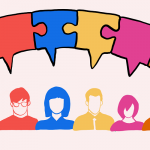Opinion: Why universities need effective diversity courses
UW Tacoma is keen to promote its diverse student body and call itself an urban-serving campus. But is achieving visible diversity enough to suggest we value diversity?
This fall, our campus responded to news that student leaders were casually using the N-word in campus housing. Despite forums on the issue, some students feel there is still work to be done in terms of creating a more tolerant and understanding environment at UWT. Can diversity courses be a part of the solution?
One of my favorite definitions of diversity comes from Queensborough Community College. Paraphrasing, it states: Diversity is the recognition, acceptance and respect towards individuals despite difference.
Conversely, limited perceptions of the world create an atmosphere of ignorance and hatred or fear of the unfamiliar.
For example, UWT and other campuses like The University of Puget Sound were targeted this year with a series of intolerant messages linked to a white nationalist movement. These messages were taped onto certain doors around their campuses.
According to the Southern Poverty Law Center, hate crimes in the United States have skyrocketed. In 2017, there was a record of 7,175 hate crime incidents reported nationally. These numbers reflect a 17 percent increase from the previous year.
In times like these, universities cannot afford to let the appearance of a diverse student population make them self-congratulatory and idle in their efforts to promote diversity. It’s not enough.
So, to combat hate and intolerance, UWT and many campuses across the nation have made diversity courses a part of their general education requirements — but are they effective?
Diversity courses, as defined by UWT’s general education requirements, are courses that “focus on the sociocultural, political and economic diversity of human experience.”
So — what makes a diversity course effective? I interviewed Tanya Velasquez, a senior lecturer whose sociology courses focus on race and racisms, and asked her about the subject of diversity courses.
Q: Are there any preconceived notions about diversity courses? If so, how can we combat them?
Yes, there are. On a practical level, students have said, “I just need to know how to answer the diversity question during an interview,” or they are seeking advice about how to get along with (insert any racial, ethnic, religious or sexually minoritized group here) in the workplace. Therefore, some students think diversity courses are lightly organized around superficial, vague ideas and behaviors like “embracing or celebrating differences” and “treating everyone equally” — which most people believe they already do. This insufficient approach is the “McDisneyfication” of anti-oppression work, stripping it of all its power to create real change. It’s less challenging, apolitical, and therefore much more appealing to do “diversity-lite,” free from the cognitive dissonance that is necessary to develop and maintain a critical consciousness about the roots of inequality across race, class, gender, sexual identity, ability, etc. and the ways we may be personally complicit. To combat the preconceived notion that diversity courses are simply “value-added” — or worse, cultural tourism — we have to begin by deconstructing individualistic approaches that divorce thinking or behaviors from history and power. Further, we must challenge the myth of meritocracy and colorblind racism. I mention race specifically because in education, we often use the word “diversity” when we really mean race or racism. As educators, it’s our job to introduce a more critical and explicit way of talking about racism, sexism, classism, ableism, heteronormativity and so on, as products of oppressive, interlocking systems and structures not just the result of individual “bad actors.” Also, students must begin with a meaningful examination of their own group identities and where they have been placed in our social hierarchy — historically, economically, socially, culturally and politically.
Q: What is your definition of an effective diversity course?
My definition of an effective diversity course is based on research conducted by practitioners and scholars in the field, and the counter-hegemonic narratives of those whose very lives we are moving from the margins to the center. A social justice curriculum that teaches students to critically think about structural inequality, as well as excavate their own implicit biases, can provide a starting point for students to understand how institutional racism functions and rethink their worldview for greater social change. So, an ideal experience is one that creates transformative, liberatory spaces for learning that dismantle interpersonal power dynamics and allows students to imagine themselves as emerging anti-oppression advocates or activists. It’s unrealistic to think that this kind of learning outcome is wholly possible in one quarter. Research consistently shows that positive, sustainable change must be addressed beyond one course or a series of workshops. In other words, my definition of an effective diversity course is one that’s never done. An effective diversity course will promote a lifelong commitment to on-going learning that comes from a place of humility so that we can work in coalition with others in the struggle.
Prior to transferring to UWT, I attended Bellevue College where I took a course called Race in the United States. This course was effective not only because of the material I learned, but also because of the knowledge and passion of the instructor. It taught me skills such as examining and confronting biases, as well as articulating my ideas. Therefore, I believe all staff, faculty and administration should be required to take diversity courses so that when racial tension arises on campus, they will have the knowledge and skills to intervene or correct intolerant behavior.
In a time rife with open racial conflict, we need more than cursory diversity courses that make people “celebrate differences.” We need effective diversity courses for everyone — courses that specifically tackle the ugliness and uncomfortableness of racism, both individually and institutionally. These are the first steps to turning obstacles like intolerance into opportunities for greater understanding.







